by Frank Guzauskas
The Find
I got the phone call in October, 2015, from an owner’s friend inquiring about repairing two MGBs sitting in a storage unit in Charlotte, North Carolina. He didn’t know much about the vehicles, but saw my name and phone number as president of the Metrolina MG Car Club. “Are they up for sale?” I asked. He answered, “Probably.“ I contacted our club expert on MG cars, Bob White, and asked if he could take a look with me. A few days later, we met the lady owner and her friend at the storage unit. Lo and behold the friend was correct: there sat a 1974 1/2 GT and a 1978 Roadster.
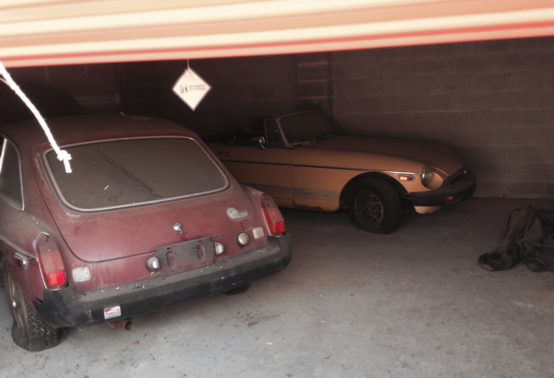
The cars were in terrible condition. When the lady’s husband was alive, the cars were kept outside most of the time and then ended up in storage for 15 years. After inflating the tires, we rolled the cars back and forth, and found that the crankshafts turned in 4th gear. Initial inspection showed a lot of typical corrosion along the bottom fenders, rocker panels, front and rear areas, the bonnet and boot. The interiors were worn, cracked and torn, although the convertible was worse due to a torn top. There were years of dust and dirt, mouse & squirrel nests, droppings, and of course rotted tires. Real diamonds in the rough!
Bob walked out of the unit and asked the smiling lady if she wished to sell them, and without any hesitation, she replied “Sure!” Bob, being straightforward, yet pleasant, informed her that the cars were in very bad shape and offered her the salvage value of $250 each, to which she replied, “Deal.” Well, that was quick, I thought. Bob then turned to me and said, “Which one do you want?” Since my 6 foot 2 inch frame is a tight fit in my ’72 Midget, the convertible was the logical choice. Even though the GT was the more valuable car, I was drawn to the roadster. Turns out I lucked out—Bob ended up pulling the GT’s engine out due to low compression issues.
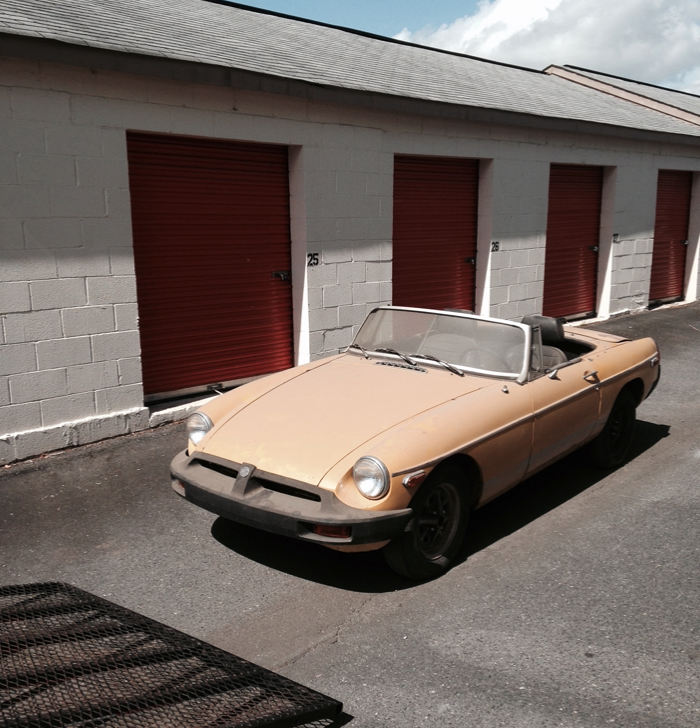
I arranged for another friend, using his truck and trailer, to help me transport the pitiful yellow roadster back to my garage. While driving back I examined the old yellow title indicating my car was purchased from a man in Mt Holly on 4/9/98, but it never was officially transferred to the lady. In other words, it technically was still his and he was nowhere to be found! Uh oh, I thought, this could be a nightmare getting the car legally transferred into my name. I’ll deal with that later. Right now I have to figure out how in the world are we going to back the trailer up an extremely steep driveway, then push and roll the car into the garage. As soon as we arrived I phoned two retired friends to help, and they were at my driveway within 15 minutes. It became immediately clear we could only move the car on the inclined trailer less than one foot at a time. So, we gave it the first push but only moved the car about 6 inches. We then chocked the tires, got our breaths back, and on the count of three pushed again. It took about six attempts before the rear tires were on the wheel ramps angling downward and soon the MGB rolled into the garage. It was at this time I realized the steering was frozen—I couldn’t budge the steering wheel left or right, another challenge I didn’t expect. I thanked my friends as they left exhausted, jacked the car up, placed wheel dollies underneath the tires, lowered the car and slowly wiggled and pushed the car up against the wall.
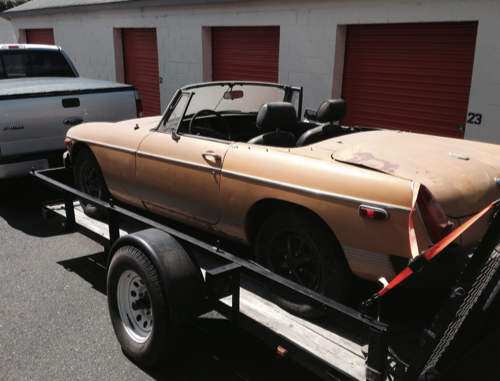
Clean and Assess
Repair, Replace, Restore
To me, the logical first priority was the engine. The hood opened up okay but there wasn’t a hood prop, so a long cardboard tube did the job. Looking at the engine bay made me wince. The Zenith-Stromberg carburetor was partially attached, the brake master cylinder and the clutch master cylinder were empty, and the radiator was damaged and corroded. Dirt and crud were everywhere, rodent nests hidden behind the brake booster and along the firewall, ragged and torn insulation hanging from the hood, and a red wire from the fuse box thru the firewall to the instrument panel? It went to the fuel gauge… seriously? I pulled that wire, enough said. I vacuumed and wiped down with degreaser the entire engine bay and tore away the insulation from the hood. At least now I have a clearer picture.
Over several weeks I disassembled the carburetor, cleaned and replaced various carb parts using a rebuild kit, then reattached it to the intake. I was able to purchase a rebuilt air temp. regulator, shroud, and flexible metal hose which I attached to the carburetor. The Stromberg carburetor and this odd looking plumbing to the air cleaner was a direct result of U.S emissions requirements. The B-Series engine’s twin SU’s failed passing the emissions mandate; thus in Dec. 1974, Abingdon went to the single Stromberg. It’s been estimated that the engine loses about 19 bhp with this factory set up, however, there is disagreement on this.
I replaced all hoses, drained the at least 15-year-old dirty oil, replaced the oil filter and poured in fresh 20W50. Then I replaced the spark plugs and wires, replaced the ignition coil, replaced the fuel filter, and drained and replaced the coolant. (The radiator had a leak of course.) Next I drained the gas tank and took a chance by partially filling it with fresh gas, and replaced the battery. (A few weeks later I also replaced the gas tank and radiator.) The engine was not seized, so I didn’t pursue spraying WD-40 or pouring Marvels Mystery Oil into the ports. Will it start? It did after a couple of shots of starting fluid! It coughed and wheezed until I adjusted the fuel mixture and idle. I could tell the valves needed adjusted as well as the timing and was surprised the original factory electronic distributor was still in use. Several months later I was told by Bob to trash the distributor; the old factory ones were not reliable and would fail. A word of warning when installing a new distributor: make sure the shaft is all the way in and the holding clamp fits securely because the distributor will loosen itself. One time I drove from Charlotte with low power, stopping several times to advance the timing by turning the distributor by hand in order to get back home. I didn’t have any tools so that was the best I could do.
I examined the brakes and determined new rotors, disc pads, front brake hoses, and new brake shoes and wheel cylinders for the rear were in order. The front brake calipers were okay. A new brake master cylinder was installed due to the old one’s cracked reservoir. The brake lines were bled. Fresh grease was injected in all fittings I saw along the suspension components. The steering was seized due to the steering rack being bone dry. With the car on jack stands I filled the rack with oil and with gentle pressure turned the steering wheel back and forth until it broke free. Suspension bushings were replaced front and rear. The Rostyle wheels were sandblasted, then painted solid black and new tires fitted on the newly painted wheels.
Both the clutch master cylinder and slave cylinder proved to be difficult to remove due to where they were located. I ended up breaking the hydraulic line from the clutch slave to the clutch master while attempting to loosen the slave cylinder bolts, thus I had to install a new line which was a new challenge bending and securing it along the fire wall, and bending again to fit the master cylinder. After bleeding the line at the slave cylinder, and getting good resistance on the clutch pedal, I decided the next step was to test the gearbox with the engine running while the car was on jack stands. I was happy and relieved that all four gears and reverse shifted smoothly as the wheels turned without any shaking or grinding. It is well known the MGB gearbox is strong and reliable.
The weather was clear, the temp was in the 50s on Dec. 23, and we were ready for Christmas; the house was decorated inside and out. Do I dare warm the B up, engage reverse gear and let it down the steep driveway? I pumped the brakes several times and slowly let the clutch out, hoping the car wouldn’t break loose and end up in my neighbor’s back yard. Everything was just fine as I slowly backed downward and into the street. I drove around the neighborhood under 30 mph and engaged the gears with ease.
As a side note, what a big difference when compared to my 1972 MG Midget. The Midget’s 1st gear is going out and even in 4th gear there are rattling noises; just a matter of time when it lets go. (As of this writing, 1st gear and reverse did break. I replaced the gearbox.)
It was very obvious the front end leaned downward due to the old, collapsed coil springs. Changing them out was a bit tricky. Releasing the old springs was simple, however, lining up and securing the new coils under tension on the wishbones took a lot of patience.
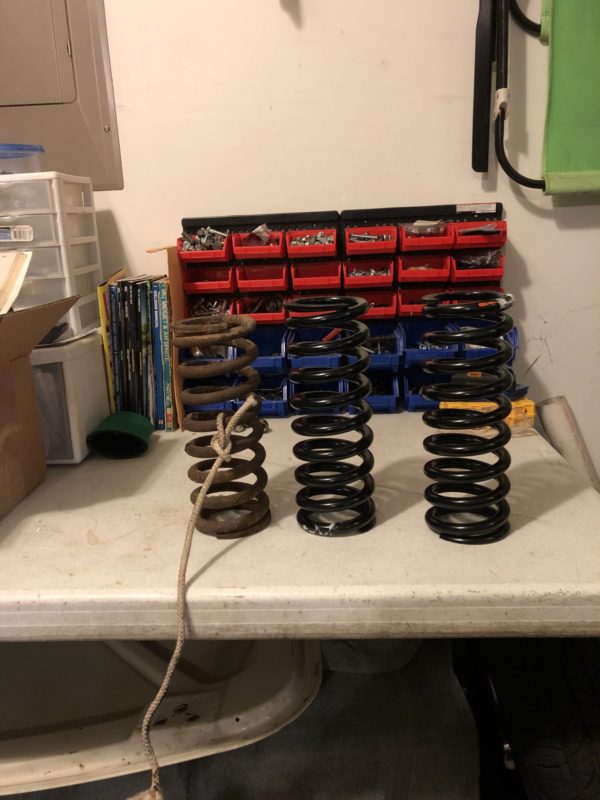
Ownership Is Easier Said Than Done
Over the next year I actually drove the yellow rust bucket to club events, illegally! I was warned by a retired police officer in our club that if I was pulled over, I’m in big trouble. I did not have any legal ownership proof, therefore no registration proof nor a legal license plate, thus the car would be impounded with fees and fines. And, until I show proof of legal ownership, proper registration and tag, it would remain impounded. I did have insurance! The frustration started with the lady from whom I bought the car. She never had the title transferred over to her at the DMV yet she had possession of the title. I contacted her about the title and was able to meet her and a notary public at her work office. He (notary public) looked at the title and told me to sign on the back page and then he stamped it and left. As I left her office, I had a bad feeling this wasn’t correct and I had just signed a notarized document in error! My second option was to track down the previous legal owner, and by a stroke of luck, I was able to locate him close by. I explained the situation and asked him if we could meet in a few days at a “quick title” DMV office in Charlotte and transfer the title to me. Unfortunately, he was a HVAC technician working most of the time out of town, so back to square one. I decided to visit the quick title DMV office myself with title in hand to ask how I get this mess fixed. The lady clerk looked at the old “yellow” title front and back and said, “This is all wrong.” I said, “Ma’am, I know, can you help me?” First, she typed a statement stating I was not intentionally trying to defraud the state of North Carolina, and then instructed me to sign it in order to put the statement in the file. After conferring with her supervisor, she handed me “power of attorney” forms and instructed me to go back to the lady I purchased the car from, and in the presence of a notary public have her sign them giving me the power to: (a) transfer the title to her name and then (b) transfer the title from her to me. The lady was willing to meet me at a UPS Store that had a notary public after I explained the situation. Her reason for not transferring and registering the car was that both the GT and the Roadster were in-operable, thus she wasn’t going to pay the yearly property taxes on two broken vehicles. After expressing my gratitude for her cooperation, I drove straight to the quick title DMV and waited for the lady clerk. She saw me sitting and motioned me to come up. She reminded me of my 6th grade teacher, Miss Ball, with her head pointed downward, her glasses slid down her nose, while her eyes above just stared at me. I meekly handed her the power of attorney paperwork. “I need a copy of her driver’s license,” she said in a dead pan tone. “This is to verify she is the person on the power of attorney forms.” Why didn’t she tell me this the first time, I thought? Sensing my frustration, she changed her tone and said, “Call her while you’re sitting here and get her to take a photo of her license and text it to you. I can copy it for the files and then we can get started.” Easier said than done, I thought, but I did reach out and, you guessed it, she didn’t answer. The clerk said, “When you reach her come back and we’ll start again.” How many trips will it take going back and forth to the DMV before I get a correct title? Turns out, I did reach the lady that afternoon and after several attempts taking the photo of her license, she sent it via a text attachment. I raced back to the DMV and waited in line hoping I could put this thing to bed. I showed the lady the photo on my phone, she then made a copy by placing the phone in a copier machine, and produced a paper copy, but there was another problem: we could not read the driver license number; it was blurred! My heart sunk as I sat across the desk. I called the lady again, and asked her to place her license card flat on a counter or desk and hover the phone directly over it to make sure everything is readable, then tap the button. This time it looked good, and the lady clerk was able to read the number. “Boom!”… we are headed for the finish line! She started tapping on her computer keyboard and produced a title form stating the lady owner purchased the car. I signed it as power of attorney. The next form stated I purchased the car from the lady which I also signed. She produced a new title in my name and we were finished. In essence there were two “quick” titles created so I had to pay twice, but by now I didn’t care. I am now LEGAL.
Bodywork
Rocker panels, fenders, doors, trunk lid, hood, and lower front end all had various degrees of corrosion. One has to assume the B was driven a lot in winter months since the passenger side had more rust than the driver side. Salt and brine mixtures tend to accumulate on the roadside edges thus exposing and splattering the far side of the car more than the near side.
As any enthusiast knows, pre-cut, shaped metal sections, as well as full body pieces are available at Moss Motors. Buying them isn’t the problem, but being a novice at cutting and welding sheet metal parts is. Bob told me to come over to his shop and he’ll show me how to MIG weld. “If you feel confident enough to do this, then buy a welding machine and practice, practice, practice.” After watching Bob spot weld two metal pieces, I tried it. It was clumsy at first, but I decided I could do this. A week or so later, Bob contacted a man in Georgia who was selling his B as well as some tools, including a fairly new Lincoln Electric MIG welder with cart, gas and accessories. Bob was only interested in the car, so I spoke to the man on the phone without seeing the machine and asked him how much. He said, “Make me an offer.” I told him $100 which he quickly replied “sold.” Since Bob was trailering the 1970 “B” back, he would bring the welder along. We met at an I-85 exit and loaded the welding machine, cart, etc., into my SUV and payed Bob the $100.
I researched the correct techniques of scribing and cutting out rusted areas, overlapping replacement sections, clamping them securely, and MIG welding. There were times I made mistakes and wished I had gone to classes at the local community college. For example, when grinding down a weld, holes would appear because of sloppy welding and/or weak, old, thin metal. Many times I had to walk away and try again the next day. Such is the plight of a novice, but eventually I managed to accomplish the task. The replacement sections were left and right rear fender dog legs, left and right lower front fender panels, and small cut out sections of the right side (far) rocker panel. Upon close examination, after cutting the corroded areas in the rocker panel, as well as the end cap by the wheel well, I discovered by using a flashlight viewing from the open end cap area, that the inside tunnel was rust free. This saved me a lot of headaches since there was no need to drill thru rivets, remove the doors, and cut the rocker panels out while also bracing the door openings.
When applying filler putty over the weld areas I discovered one must start several inches above, below, and horizontally to smooth out any appearance of ground down weld lines. When you shoot primer and let it dry you really see crests, valleys and pin holes! The only way to fix it is to sand the area down and start over. Many areas were redone, some several times.
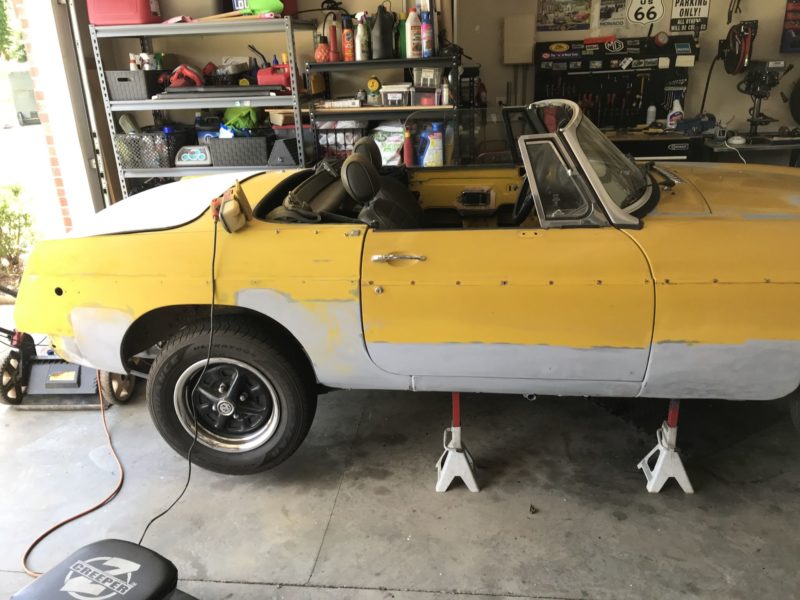
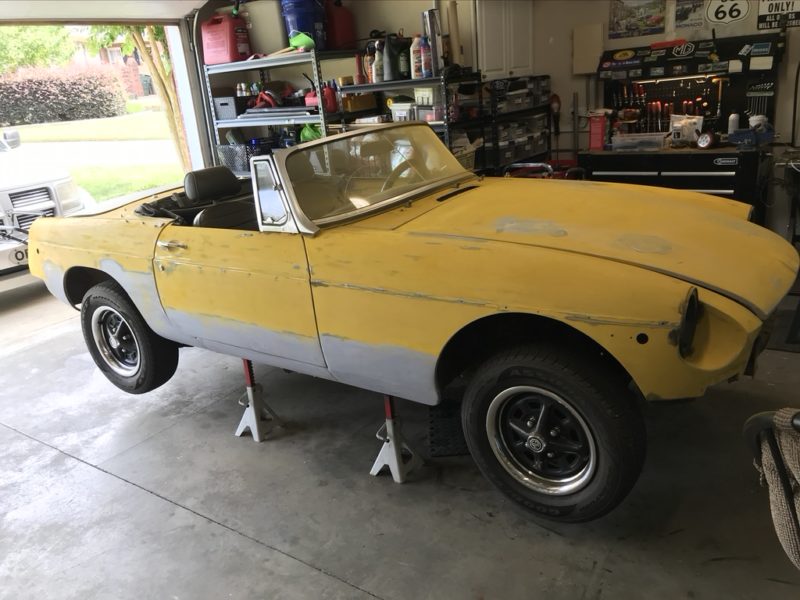
The boot lid was replaced with a 1966 lid and yes it has the old badging. The original lid was pushed up from underneath, probably because a previous owner had tried to cram something rigid inside, thus bowing the metal beyond repair.
Rescued and Ready to Rock & Roll
I checked out local paint shops, but the one I really wanted turned me down due to a huge backlog of collision repairs and lack of reliable workers. The owner, who collects muscle cars, said he would love to do restorations but just couldn’t fit these in his schedule. I decided to go with a body shop in Clover, South Carolina whose owner was familiar with MGs and quoted a reasonable price to scuff sand, primer and paint my “B” with the original Inca Yellow paint specs. Once it was painted, I cleaned and painted the seat frames, replaced the webbing, foam and seat covers, installed new carpet and interior panels, and new seat belts. I replaced the convertible top (Moss Motors) after viewing an excellent DVD explaining the step by step procedures. It was fairly simple to do and the top looks great.
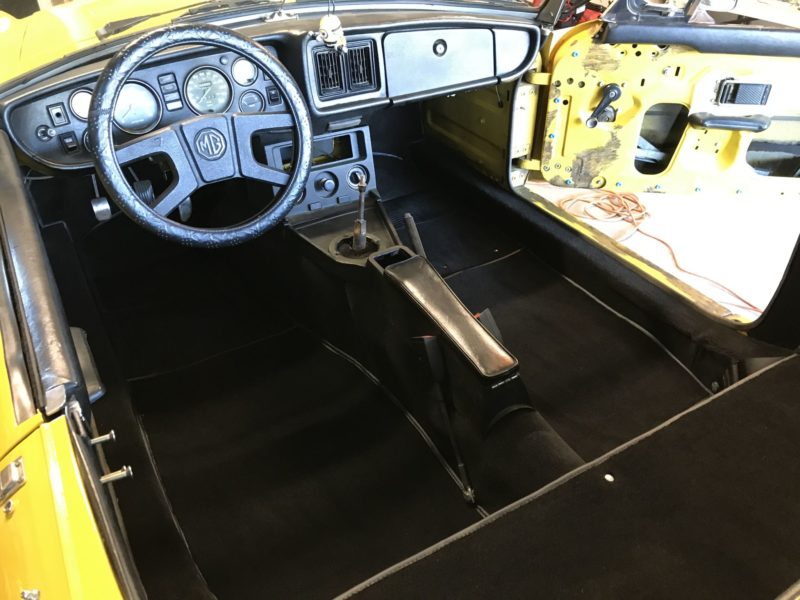
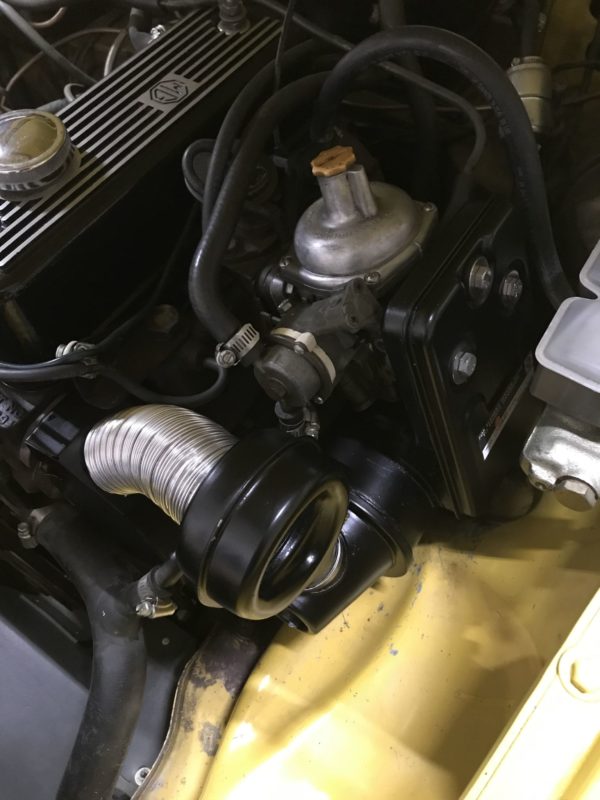
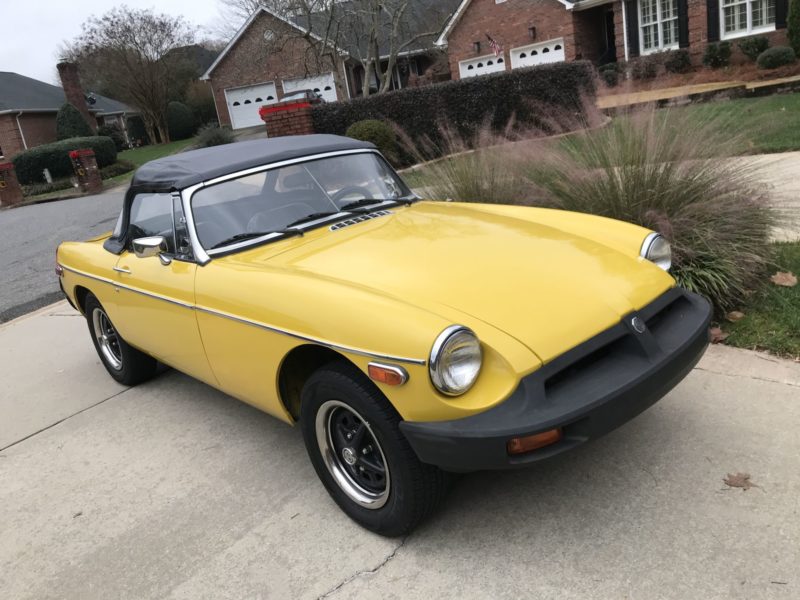
This was never going to be a “show car” but simply a decent looking 1978 yellow MGB. I used to fret over my bodywork, but a member in our Metrolina MG Car Club, Andy, always mentions the 50/50 rule when describing his Jag E-Type Coupe: at 50 feet away and at 50 mph his Jag looked fantastic. He told me I should do the same and just enjoy the car. He was absolutely right.





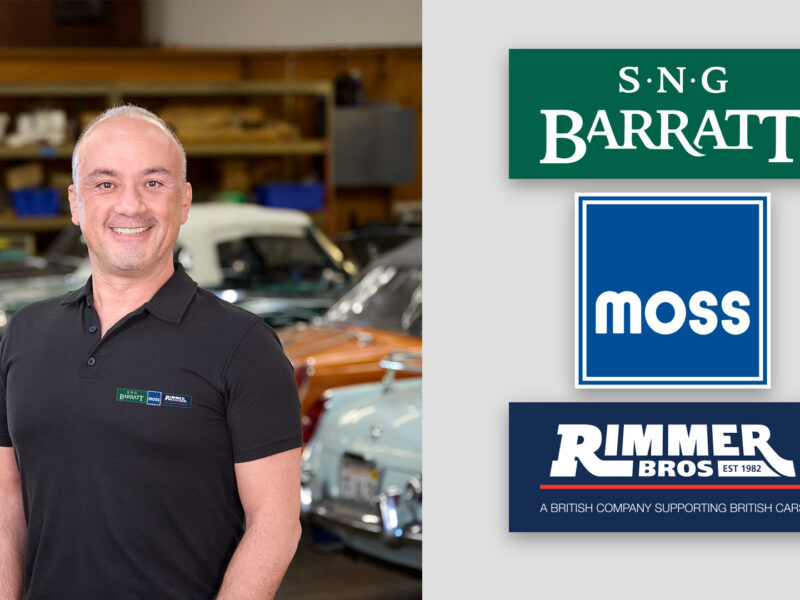
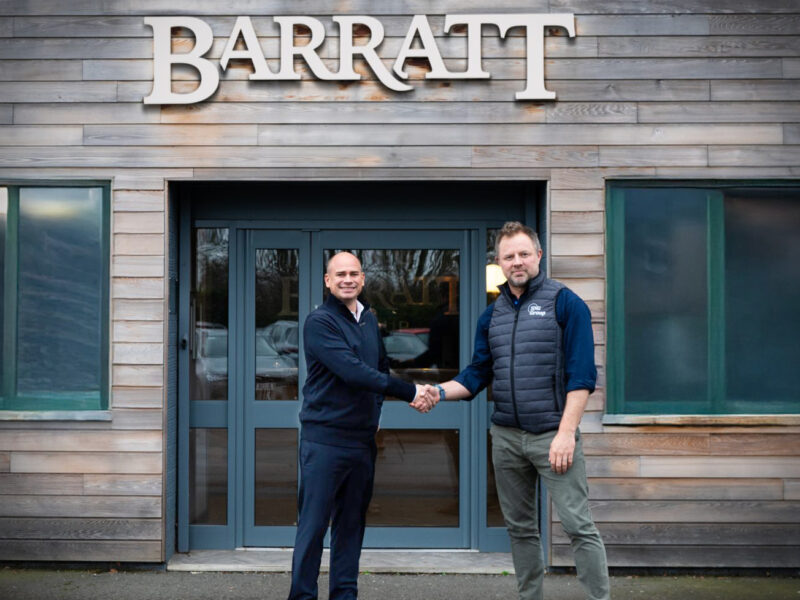
'Another One Rescued' has 1 comment
December 6, 2022 @ 5:40 pm Nestor Cortes
What an ordeal, but in the end it was worthwhile. You did a great job. Both, mechanically and communicating your process.
I have a ‘73 B. That hasn’t been moved in 10 years because I worked overseas. I’m now retired and looking forward to follow your steps. If I do half the job you did, I will claim victory!